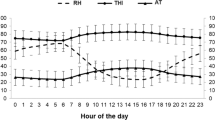Abstract
Twelve crossbred heifers (Slovak Spotted x Holstein-Friesian) were housed in an open, uninsulated barn with straw bedding and a concrete-floored yard. Minimum temperatures inside the barn were as low as −19°C. The average milk yield decreased as the temperatures approached these minima. Compared with the temperate conditions, the feed intake and blood levels of glucose and free fatty acids increased. The level of sodium declined significantly during the second cold period. Correlations and regressions between milk yield and biochemical parameters were calculated, and the results indicate that the concentrations of free fatty acids, cholesterol, and triiodothyronine and the haematocrit values may serve to predict milk production during periods of cold stress, or in lactations of 305 days.
Similar content being viewed by others

References
Ames D (1980) Thermal environment affects production efficiency of livestock. Bioscience 30:457–460
Beattie D (1978) Physiological changes in rats exposed to cold stress. Life Sci 23:2307–2314
Bianca W (1971) Die Anpassung des Haustieres an seine klimatische Umgebung. Schweiz Landwirtsch Forsch, 10:155–205
Brouček J, Kovalčik K, Gajdošík D, Brestenský V (1987) The effect of extreme ambient temperatures on haematological and biochemical parameters of heifers. Veter Med 32:259–268
Christopherson RJ, Young BA (1986) Effect of cold environments on domestic animals. In: Gudmundsson O (ed) Grazing research at Northern latitudes. Plenum, pp 247–257
Girardier L, Stock MJ (1983) Mammalian thermogenesis. Chapman and Hall, University Press, Cambridge
Grube E, Backs B (1985) Statistics 1, Rev 5, 22, Section 1.4. Med Univ Hosp, Bonn
Horwitz BA (1971) Brown fat thermogenesis: Physiological control and metabolic basis. In: Nonshivering thermogenesis. Proceedings of Symposium, Praha, pp 63–65
Johnson HD, Vanjonack WJ (1976) Effects of environmental and other stressors on blood hormone patterns in lactating animals. J Dairy Sci 59:1603–1617
Johnson HD (1986) The effects of temperature and thermal balance on milk production. In: Moberg GP (ed) Limiting the effects of stress on cattle. Utah State University, Res Bull 512: 33–45
Johnson HD (1987) Bioclimate effects on growth, reproduction and milk production. In: Johnson HD (ed) Bioclimatology and the adaptation of livestock. Elsevier, Amsterdam, pp 35–57
Kriesten K (1981) Aspekte der zitterfreien Thermogenese bei Säugetieren — Eine Übersicht. Der Prakt Tierarzt 62:500–505
MacDonald MA, Bell JM (1958) Effects of temperature on milk yield and milk composition. Can J Anim Sci 38:160
Robertshaw D (1981) In: Clark JA (ed) Environmental aspects of housing for animal production. Butterworths, London, pp 181–192
Shijimaya K, Furugouri K, Miyata Y (1985) Effects of cold temperature on the milk production and some physiological responses of lactating cows. Jpn J Zootech Sci 56:704–710
Young BA (1981) Cold stress as it affects animal production. J Anim Sci 52:154–163
Young BA (1983) Ruminant cold stress: effect on production. J Anim Sci 57:1601–1607
Author information
Authors and Affiliations
Rights and permissions
About this article
Cite this article
Brouček, J., Letkovičová, M. & Kovalčuj, K. Estimation of cold stress effect on dairy cows. Int J Biometeorol 35, 29–32 (1991). https://doi.org/10.1007/BF01040960
Received:
Revised:
Accepted:
Issue Date:
DOI: https://doi.org/10.1007/BF01040960



